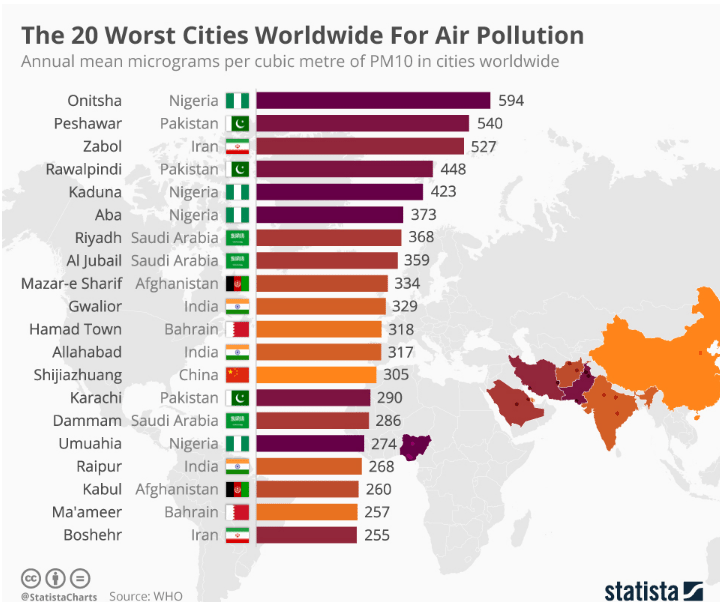There is a compelling case for deploying LPWA networks to monitor local air quality in smart cities
More than three million people die prematurely each year because of ambient air pollution caused by high concentrations of small and fine particulate matter, according to the World Health Organization (WHO). That makes air pollution the greatest environmental risk to health.
Ahead of the World Health Assembly in Geneva this week, the WHO estimated that more than 80% of people living in urban areas are exposed to air quality levels that exceed WHO limits. And that figure relates only to those cities that actually monitor air quality.
In other words, air pollution is now a very serious health challenge, as well as an environmental issue, in a fast urbanising world. Although there should be a compelling socio-economic case for using Internet of Things technologies to get a grip on this problem, the issue may be falling into the cracks between central and local governments. The “to do lists” of smart cities units tend to focus on connecting infrastructure and services, such as street lighting, waste collection and traffic management systems, rather than trying to tackle health issues, which are usually the concern of central government (for more on smart cities’ priorities, join our webinar on June 1st). But monitoring air quality could ultimately yield much greater societal benefits than smart city solutions focused on efficiency savings, both in terms of quality of life and reducing healthcare costs and working days lost to illness.
Conduct a broad cost-benefit analysis
With the advent of low power, wide area (LPWA) networks, which should lower the cost of connecting sensors substantially, health authorities and municipalities could team up to do a cost-benefit analysis on the deployment of connected air quality monitors throughout urban areas. Such an analysis is likely to show the socio-economic benefits will be substantial. The localized data collected by connected monitors could be used to predict when air quality will deteriorate in specific neighborhoods, enabling health authorities to warn vulnerable citizens, such as the elderly or asthmatic, to stay indoors, use inhalers and avoid strenuous exercise.
Integrating localized air quality data with traffic data and weather data could also help long-term and short-term transport, waste management and energy planning – three major factors influencing air quality. A city administration may decide to close particular roads or suspend waste incineration when the air quality in a neighborhood drops below certain thresholds.
As they can support tens of thousands of connections in a single cell, LPWA networks could be used to capture information from air quality monitors on every street corner and set of traffic lights. Some of these connections could also be used to transmit information from sensors tracking noise levels and the movement of vehicles, thereby helping municipalities pursue other objectives.
Air quality analytics firm BreezoMeter and Current, a new energy-focused unit within GE, have forged a partnership aimed at providing cities with real-time air quality and traffic analytics through the deployment of connected street lights equipped with appropriate sensors. The partners say that city leaders will be able to use the data they capture to help reroute and organize traffic to reduce air pollution and congestion.
Raising awareness and engaging citizens
Some startups are also experimenting with mobile air quality sensors. Plume Labs has attached such sensors to some of London’s ubiquitous pigeons, while also asking for human volunteers to carry them around the city. It then uses Twitter and its apps to relay the results to interested Londoners.
In a blog post, Plume Labs CEO Romain Lacombe stressed that attaching sensors to pigeons isn’t just a publicity stunt: “Air pollution is a huge environmental health issue, killing 10,000 people every year in London alone. Putting air sensors on the back of pigeons goes beyond raising awareness of this problem and helps Londoners understand the impact of pollution in an accessible, tangible and immediate way.”
In any case, the importance of raising awareness shouldn’t be underestimated. Monitoring air quality in a way that is very visible to a city’s residents would help to engage the population in caring for their immediate environment and would also stimulate more interest in smart city solutions.
Although the WHO says many of the cities with the worst air quality are in low income countries with little public money to spend [see graphic], some are in countries with large and/or fast growing economies.

Saudi Arabia, China, Bahrain and India all have cities that fall in the top 20 for worst air pollution. If these countries were to deploy LPWA-based air monitoring solutions in their major cities, other poorer countries could benefit from the ensuing economies of scale and the lessons they learn.
During the first industrial revolution, London had really filthy air. Over the past century, the UK capital has gradually cleaned up its act. Equipped with the latest digital technologies, today’s fast developing cities will have the tools to move much more quickly. Now is the time to act on air quality.
